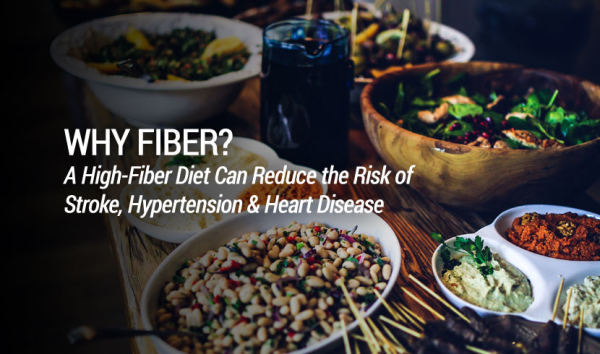Despite its popular association with trips to the restroom, fiber is no joke. The benefits of an efficient bowel aside, a high-fiber diet can also reduce the risk of stroke, hypertension and heart disease. Unfortunately, fiber consumption is currently at an all-time low, with less than three percent of Americans meeting the recommended intake.
Why Fiber?
Fiber is something the body needs but never actually digests. It remains more or less the same from plate to toilet. It comes in two varieties, soluble and insoluble, and most plant-based foods contain a mixture of the two. Soluble fiber turns to gel in the stomach and slows digestion, which helps lower cholesterol and blood glucose. Insoluble fiber, on the other hand, remains unchanged all the way to the colon, making waste heavier and softer so it can wiggle through the intestines to elimination. Regardless of these differences, neither type of fiber is ever absorbed into the body.
Eating too little fiber can make it tough to control blood sugar and appetite because fiber regulates the speed of digestion and contributes to feeling full. Skipping out on a daily dose of fiber often leads to constipation. There can be too much of a good thing, though. Overdoing it with fiber can move food through the intestines too quickly, which means fewer minerals get absorbed from food. It can also result in gas, bloating, and cramping, especially when fiber intake is dramatically increased overnight.
So what’s the magic amount? The Institute of Medicine recommends that men under 50 eat about 30-40 grams of fiber each day. Adults over 50 require less fiber of 25-30 grams of fiber due to decreased food consumption.
The Best High-Fiber Foods
Note: The amount of fiber in these foods can vary slightly between the raw and cooked versions.
| Legumes, nuts and seeds | Serving size | Total fiber (grams)* | ||
| Split peas, cooked | 1 cup | 16.3 | ||
| Lentils, cooked | 1 cup | 15.6 | ||
| Black beans, cooked | 1 cup | 15.0 | ||
| Lima beans, cooked | 1 cup | 13.2 | ||
| Baked beans, vegetarian, canned, cooked | 1 cup | 10.4 | ||
| Sunflower seed kernels | 1/4 cup | 3.9 | ||
| Almonds | 1 ounce (23 nuts) | 3.5 | ||
| Pistachio nuts | 1 ounce (49 nuts) | 2.9 | ||
| Pecans | 1 ounce (19 halves) | 2.7 | ||
| Vegetables | Serving size | Total fiber (grams)* | ||
| Artichoke, cooked | 1 medium | 10.3 | ||
| Green peas, cooked | 1 cup | 8.8 | ||
| Broccoli, boiled | 1 cup | 5.1 | ||
| Turnip greens, boiled | 1 cup | 5.0 | ||
| Brussels sprouts, cooked | 1 cup | 4.1 | ||
| Sweet corn, cooked | 1 cup | 4.0 | ||
| Potato, with skin, baked | 1 small | 3.0 | ||
| Tomato paste | 1/4 cup | 2.7 | ||
| Carrot, raw | 1 medium | 1.7 | ||
| Fruits | Serving size | Total fiber (grams)* | ||
| Raspberries | 1 cup | 8.0 | ||
| Pear, with skin | 1 medium | 5.5 | ||
| Apple, with skin | 1 medium | 4.4 | ||
| Banana | 1 medium | 3.1 | ||
| Orange | 1 medium | 3.1 | ||
| Strawberries (halves) | 1 cup | 3.0 | ||
| Figs, dried | 2 medium | 1.6 | ||
| Raisins | 1 ounce (60 raisins) | 1.0 | ||
| Grains, cereal & pasta | Serving size | Total fiber (grams)* | ||
| Spaghetti, whole-wheat, cooked | 1 cup | 6.3 | ||
| Barley, pearled, cooked | 1 cup | 6.0 | ||
| Bran flakes | 3/4 cup | 5.3 | ||
| Oat bran muffin | 1 medium | 5.2 | ||
| Oatmeal, instant, cooked | 1 cup | 4.0 | ||
| Popcorn, air-popped | 3 cups | 3.5 | ||
| Brown rice, cooked | 1 cup | 3.5 | ||
| Bread, rye | 1 slice | 1.9 | ||
| Bread, whole-wheat or multigrain | 1 slice | 1.9 | ||
Tips to Add More Fiber to Any Meal
- Add flaxseed meal to oats, smoothies, shakes, yogurt, and baked goods. You can even try breading chicken (Free-Range) or fish Wild) with it. A two-tablespoon serving contains 3.8 grams of fiber.
- Chia seeds have 5 grams of fiber per tablespoon. When they meet with water, they get thick like gelatin that is great for thickening smoothies, making healthy puddings, or replacing eggs in cakes and cookies.
- While spinach and carrots aren’t as high in fiber as the veggies mentioned above, they can easily be added by slicing or grating them and then adding it into your dishes: Try adding some to banana bread, shakes, eggs, or even a homemade pizza
- Food processors are fiber’s best friend. Purée some cooked vegetables and add them to sauces and stews, or swap out rice for chopped-up cauliflower.

